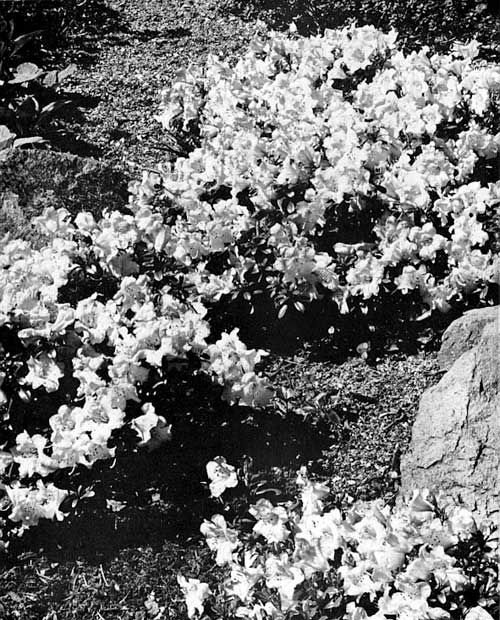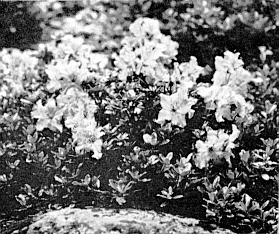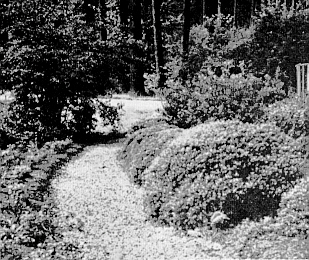Two Species - R. keleticum, R. pemakoense
by Rudolph Henny
R. pemakoense (Fig. 53) has recently been placed in the uniflorum series. Prior to this, and for over twenty-five years. It had been a member of the glaucum series. Perhaps outside of keeping abreast with the latest findings, I doubt whether this new reclassification will make any difference of greater or lesser degree to the gardener who has grown this fine species through the years. These changes and regroupings are without doubt necessary, as the overall picture of the species grows clearer.

|
|
Fig. 53.
R. pemakoense
makes low spreading mounds of evergreen
foliage and is covered in the spring with large lilac pink flowers in March or April. Plant growing in the garden of Dr. and Mrs. A. A. Grossman. Grossman photo |
Several species may be incorporated under a single name, others moved about into different series, and yet others have a complete change of name. Fine lines of differences in nearly alike plants are not now so apt to rate the title of a separate species as in years gone by. Anyone who has ever grown a group of seeds of the
R. sanguineum
series from the wild will quickly realize that in most instances hardly any two plants will be alike in color, and often the foliage and habit shows the widest variation. Without doubt this changing and regrouping is far from over, and future botanists will rearrange the names and regroup others under the single title. It is to be hoped that this be clone quickly, accurately, and with a finality. I recall in the past twenty years a single species that I purchased under the name
R. sphaeranthum
, a few years later it was changed to
R. ledoides
, and the latest current change is
R. trichostomum
var.
ledoides
, an unwieldy lengthy name that I don't think I will ever grow accustomed to. The name of course, is of minor importance, and the changing of it will not add or detract one whit from the desirability of a plant. The above few lines may answer a few of the requests directed to the editor during the last few months relative to why names of species are not changed by the Society.
R. pemakoense
is in all aspects a desirable plant, suitable for the small garden, the rockery, large border or even as a foreground plant in the woodland. It rarely grows over two feet, in height, and in a mild season will show its bloom as early as late March.
This plant was purported for many years to send out underground stolons, and spread in this manner. I have never seen a single plant of R. pemakoense that sent out even a single stolon, and I have left them uncovered, mulched them and tried both shade and an open location. Some of the plants are now twenty-five years of age, and are truly first class, but do not send out these so-called suckers.
The bloom on
R. pemakoense
is delightful, and though it is a pink purple it is quite acceptable at that early season. I always enjoy a planting of this species very much. The flowers are broad, and borne in pairs in an upright manner. The hard November freeze of 1955 cut the plants back to ground level, but all have at this date recovered.

|

|
|
Fig. 54. R. keleticum
Cecil Smith photo |
Fig. 55. Large plants of
R. keleticum
in
the garden of Mrs. A. C. U. Berry. Cecil Smith photo |
R. keleticum
is one of the favorite species in my garden, and the very dwarf form sent back by Rock under the number R. 58 is one of the finest. This seed grew plants of a rather taller form also, but in bloom and foliage they are the same as the dwarf form. The larger growing form is at this date after ten years about a foot high, and the dwarf form about the size of a clenched fist. The bloom on both types are of equal size and are usually a single bloom, very flat, much like a pansy.
The sight of one of these small dwarf plants growing very compactly, with perhaps a dozen single blooms nearly the size of a dollar in late May or even June is almost humorous. The flowers are carried on a long pedicel perhaps as much as two inches above the foliage, and always remind me of undersized flag staffs with oversized flags. The border of
R. keleticum
(Fig. 55) is in the garden of Mrs. A. C. U. Berry, and could at this time be well over thirty-five years of age.
R. keleticum
is very hardy, but resents growing in a wet location, and does best on a raised bed or a location with sharp drainage. Many dwarf plants are touchy and difficult, but such is not the case with
R. keleticum
. It seems vigorous, and hardy, and needs no special care save good drainage.